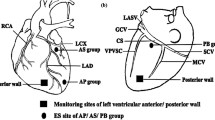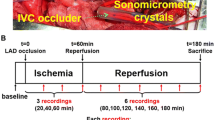Abstract
The optimal means of electrically stimulating a skeletal muscle to contract around a fluid-filled pouch (i.e., a skeletal muscle ventricle [SMV]) has not been determined. A SMV was made from the latissimus dorsi muscle in five dogs and the rectus abdominis muscle in five dogs, and each SMV was electrically stimulated via the motor nerve(s) to contract around a fluid-filled pouch, which was connected to a mock circulatory system. The pulse train duration (PTD) was varied from 100 ms to 800 ms in 100 ms increments to determine the effect of this variable upon SMV output. The pulse width of the electrical stimulus was kept constant at 100 μs and the pulse frequency was maintained at 50s−1. For SMV contraction rates of 20, 30, and 40 min−1, the optimal PTD was 400 ms for both muscles. The peak output was 710 ml min−1 for the rectus SMV and 556 ml min−1 for the latissimus SMV. For an SMV contraction rate of 10min−1, the optimal PTD was 800 ms for the rectus SMV and 600 ms for the latissimus SMV. Use of less than an optimal PTD caused reductions in SMV output of 25–50%. Although SMVs made from rectus abdominis and latissimus dorsi had similar values for the optimal PTD, the maximum SMV output was usually greater with the rectus abdominis in this acute study with untrained muscles. We conclude that PTD is an important variable to control, which can markedly affect results when studying the potential use of skeletal muscle power for cardiac assistance.
Similar content being viewed by others
References
Acker, M.A.; Hammond, R.L.; Mannion, J.D.; Salmons, S.; Stephenson, L.W. An autologous biologic pump motor. J. Thorac. Cardiovasc. Surg. 92:733–746; 1986.
Armenti, F.; Bitto, T.; Macoviak, J.A.; et al. Transformation of canine diaphragm to fatigue-resistant muscle by phrenic nerve stimulation. Surgical Forum 35:258–260; 1984.
Badylak, S.F.; Stevens, L.; Janas, W.; et al. Cardiac assistance with electrically stimulated skeletal muscle. Med. Biol. Eng. Comput. 27:159–162; 1989.
Badylak, S.F.; Hinds, M.; Geddes, L.A. Comparison of three methods of electrical stimulation for converting skeletal muscle to a fatigue resistant power source suitable for cardiac assistance. Ann. Biomed. Eng. 18(3):239–250; 1990.
Bitto, T.; Armenti, F.; Hoffman, R.K.; Stephenson, L.W.; Macoviak, J.A. Time course of transformation of dog diaphragm muscle with continuous low frequency stimulation at 10 Hz and 2 Hz Proceedings of Second Vienna Muscle Symposium, Vienna, Austria; pp. 175–179; 1985.
Carpentier, A.; Chachques, J.C. Myocardial substitution with a stimulated skeletal muscle: first successful clinical case Lancet 1:1267; 1985.
Chiu, R.C.J.; Walsh, G.L.; Dewar, M.L.;; et al. Implantable extra-aortic balloon assist powered by transformed fatigue-resistant skeletal muscle. J. Thorac. Cardiovasc. Surg. 94:694–701; 1987.
Dewar, M.L.; Drinkwater, D.C.; Wittnich, C.; Chiu, R.C.J. Synchronously stimulated skeletal muscle graft for myocardial repair. J. Thorac. Cardiovasc. Surg. 87:325–331; 1984.
Drinkwater, D.C., Jr.; Chiu, R.C.J.; Modry, D.; Wittnich, C. Cardiac assist and myocardial repair with synchronously stimulated skeletal muscle. Surg. Forum 31:271–274; 1980.
Franciosa, J.A.; Wilen, M.; Zuseke, S.; Cohn, Y.N. Survival in men with severe chronic left ventricular failure due to either coronary heart disease or idiopathic dilated cardiomyopathy. Am. J. Cardiol. 51:831–836; 1983.
Furman, S.; Denize, A.; Escher, D.W.; Schweidel, J.B. Energy considerations for cardiac stimulation as a function of pulse durations. J. Surg. Res. 6:441–445; 1966.
Geddes, L.A.; Badylak, S.F.; Wessale, J.L.; Janas, W.; Tacker, W.A. The use of electrically stimulated skeletal muscle to pump blood. Pace 13:344–362; 1990.
Guyton, A.C.; Jones, C.E.; Coleman, T.G. Circulatory physiology: Cardiac output and its regulation (2nd Ed.). Philadelphia, PA: W.B. Saunders Co.; 1973.
Kantrowitz, A.; McKinnon, W.M.P. The experimental use of the diaphragm as an auxiliary myocardium. Surg. Forum 9:266–268; 1959.
Kusaba, E.; Schraut, W.; Sawantani, S.; et al. A diaphragmatic graft for augmenting left ventricular function: a feasibility study. Trans. Amer. Soc. Artif. Int. Organs 19:251–257; 1973.
Macoviak, J.A.; Stephenson, L.W.; Armenti, F.; Alavi, L.W. Electrical conditioning of in situ skeletal muscle for replacement of myocardium. J. Surg. Research 32:429–439; 1982.
Macoviak, J.A.; Stephenson, L.W.; Alavi, A.; Kelly, A.M.; Edmunds, L. Effect of electrical stimulation on diaphragmatic muscle used to enlarge right ventricle. Surgery 90:271–277; 1981.
Macoviak, J.A.; Stephenson, L.W.; Spielman, S.; Greenspan, A.; Likoff, M., St. John-Sutton, M.; Reichek, N.; Rashkind W.J.; Edmunds, L. Replacement of ventricular myocardium with diaphragmatic skeletal muscle. J. Thorac. Cardiovasc. Surg. 81:519–527; 1981.
Magovern, G.J.; Heckler, F.R.; Park, S.B.; Christlieb I.Y.; Magovern, Jr., G.J.; Kao, R.L.; Benckart, D.H.; Tullis, G.; Rozar, E.; Liebler, G.A.; Burkholder, S.A.; Maher, T.D. Paced latissimus dorsi used for dynamic cardiomyoplasty of left ventricular aneurysms. Ann. Thorac. Surg. 44:379–388; 1987.
Malek, A.M.; Khalafalla, A. Nerve vs. muscle stimulation for power generation in Macas. Proc. of the Association for the Advancement of Medical Instrumentation, 22nd Annual Meeting, May 16–20, Los Angeles, California; 1987; p. 44.
Mannion, J.D.; Bitto, T.; Hammond, R.; Rubinstein, N.R.; Stephenson, L.W. Histochemical and fatigue characteristics of conditioned canine latissimus dorsi muscle. Circ. Res. 58:298–304; 1986.
Mannion, J.D.; Hammond, R.; Stephenson, L.W. Hydraulic pouches of canine latissimus dorsi. J. Thorac. Cardiovasc. Surg. 91:534–544; 1986.
Nakamura, K.; Glenn, W.W.L. Graft of the diaphragm as a functioning substitute for the myocardium. Surg. Research 4:435–439; 1964.
Petrovsky, B.V. The use of diaphragm grafts for plastic operations in thoracic surgery. J. Thorac. Cardiovasc. Surg. 41:348–355; 1961.
Posey, J.A.; Geddes, L.A. Measurement of the modulus of elasticity of the arterial wall. Cardiovasc. Res. Bull., Baylor College of Medicine, 11:83–103; 1983.
von Recum, A.; Stule, J.P.; Hamada, O.; Baba, H.; Kantrowitz, A. Long-term stimulation of a diaphragm muscle pouch. Surg. Research 23:422–427; 1977.
Salmons, S.; Vrbova, G. The influence of activity on some contractile characteristics of mammalian fast and slow muscles. J. Physiol. 201:535–549; 1969.
Salmons, S.; Henriksson J. The adaptive response of skeletal muscle to increased use. Muscle Nerve 4:94–105; 1981.
Salmons, S.; Sreter, F.A. Significance of impulse activity in the transformation of skeletal muscle type. Nature 263:30–34; 1967.
Solis, E.; Kaye, M.P. The registry of the International Society for Heart Transplantation: Third official report, January–February 1986. Heart Transplant 5(1):2–5; 1986.
Spotnitz, H.M.; Merker, C.; Malm, J.R. Applied physiology of the canine rectus abdominis: forcelength curves correlated with functional characteristics, of a rectus powered “ventricle”. Potential for cardiac assistance. Trans. Amer. Soc. Artif. Int. Organs 20:747–756; 1974.
Stevens, L.; Badylak, S.F.; Janas, W.; Gray, M.; Geddes, L.A.; Voorhees, W. D. A “skeletal muscle ventricle” made from rectus abdominis muscle in the dog. J. Surg. Res. 46:84–89; 1989.
Vachon, B.R.; Kunov, H.; Zingg, W. Mechanical properties of diaphragm muscle in dogs. Med. Biol. Eng. 13:252–260; 1975.
von Recum, A.; Stule, H.P.; Hamada, O.; Baba, H.; Kantrowitz, A. Long-term stimulation of a diaphragm muscle pouch. J. Surg. Res. 23:422–427; 1977.
Author information
Authors and Affiliations
Rights and permissions
About this article
Cite this article
Badylak, S.F., Wessale, J.E., Geddes, L.A. et al. Optimization of pulse train duration for the electrical stimulation of a skeletal muscle ventricle in the dog. Annals of Biomedical Engineering 18, 467–478 (1990). https://doi.org/10.1007/BF02364611
Received:
Revised:
Issue Date:
DOI: https://doi.org/10.1007/BF02364611




